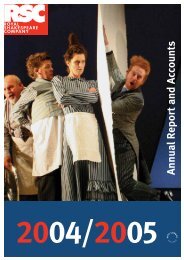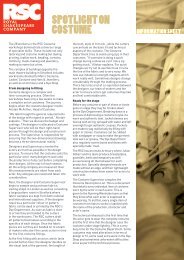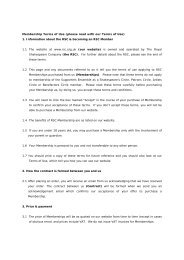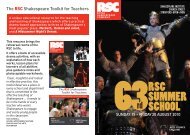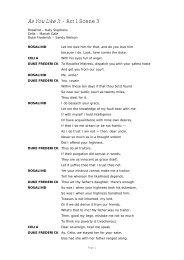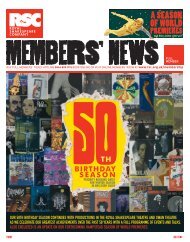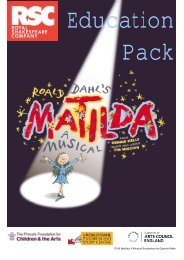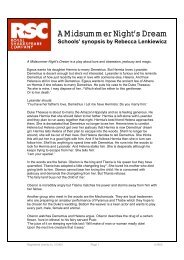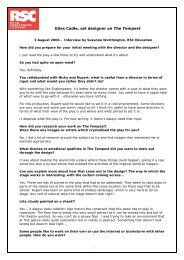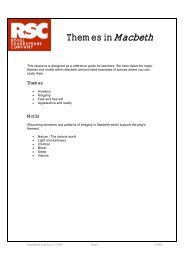THE TAMING SHREW - Royal Shakespeare Company
THE TAMING SHREW - Royal Shakespeare Company
THE TAMING SHREW - Royal Shakespeare Company
You also want an ePaper? Increase the reach of your titles
YUMPU automatically turns print PDFs into web optimized ePapers that Google loves.
INVESTIGATING <strong>THE</strong> INDUCTION [CONTINUED]<br />
<br />
Montage<br />
Ask students to read aloud the two scenes beginning on page 10 of this pack, the first<br />
from the Induction and the other from the play-within-the-play.<br />
Then ask them to work in groups of four as they create a montage of the two scenes,<br />
making them into one scene where the action moves quickly between the Sly story and<br />
Kate’s encounter with Petruchio. The links, parallels and points of comparison should be<br />
evident.<br />
Explain that this is a film technique where we see a snippet of an event in one context or<br />
setting and then jump to a different event to see what is happening elsewhere at the<br />
same time.<br />
You may want to ask that they incorporate at least three ‘jumps’ in action in their<br />
montage. Explain that they may heavily edit both scenes, using only snippets from each.<br />
If students know the play well, they can create a montage from bits of text throughout the<br />
play. There are many more parallels to be found between the Induction and the play-withinthe<br />
play outside these two scenes. (This approach might make a good revision exercise.)<br />
Ask the students to rehearse their montage scenes and perform them.<br />
Play ‘Freeze Frame’ with one or two of the scenes after they have been performed once.<br />
In ‘Freeze Frame’ any member of the audience is allowed to freeze the action at any<br />
point and address a question to one of the characters involved, for example: ‘Why did<br />
you do/say that just now?’ and ‘What are you thinking right now?’<br />
Ask them to explain their thinking behind the montage scenes they have created.<br />
In particular:<br />
What do Kate and Sly have in common in their characters and their circumstances?<br />
What plot features do the two stories share?<br />
Why would <strong>Shakespeare</strong> have included the Induction in the play?<br />
What use would they make of the Induction and Sly if they were staging the play?<br />
<br />
Kate meets Sly<br />
Either following on from the Montages above or as a stand-alone activity, ask students<br />
to write a short scene of 8 to 10 lines of dialogue in which Kate meets Sly.<br />
Before writing the dialogue they should make these decisions:<br />
Where might Kate run into Sly?<br />
Who would begin the conversation?<br />
How would they get on with one another?<br />
What might the outcome be of their encounter?<br />
Rehearse and present these scenes.<br />
Registered charity no. 212481 © <strong>Royal</strong> <strong>Shakespeare</strong> <strong>Company</strong> Page 4



